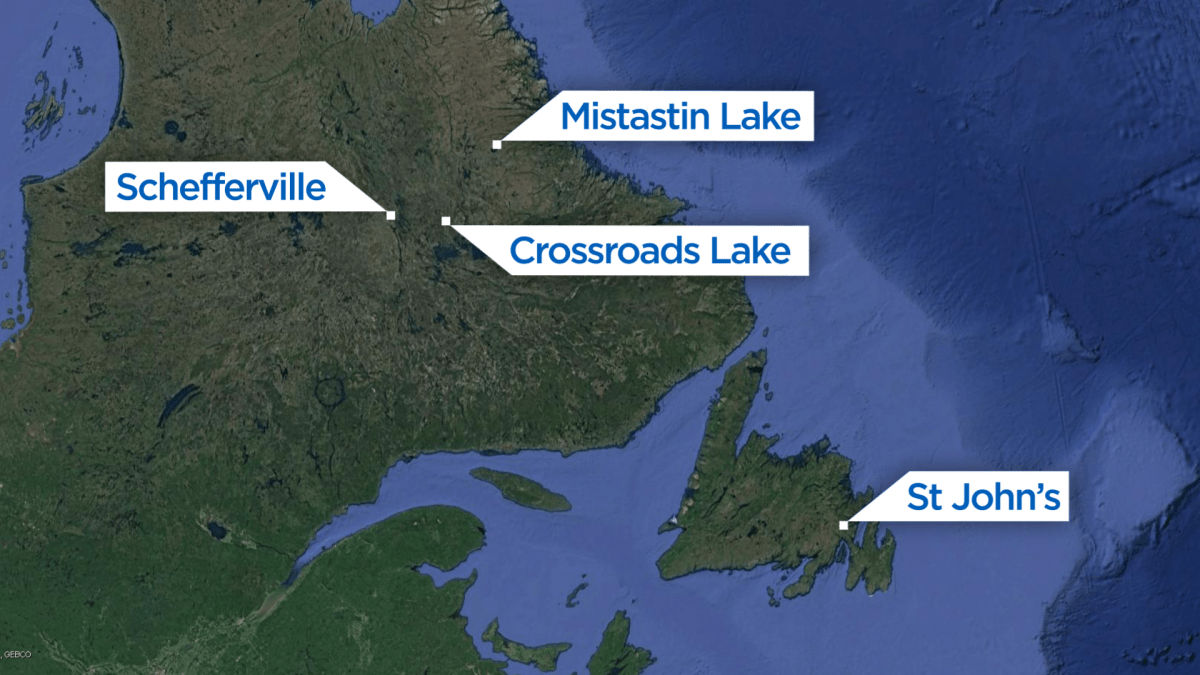An underwater recovery team is headed to a remote lake in Labrador where a float plane crashed on Monday to resume a search for the missing occupants.

The Air Saguenay float plane had been transporting the men on a fishing trip in Mistastin Lake, about 120 kilometres southwest of Nail, N.L., when it crashed into the water.
The RCMP said seven men were on board the plane at the time – a Quebec-based pilot, two guides from Newfoundland, and four fisherman from the United States.
A search and rescue team located the bodies of three victims on Tuesday.
Four other people remain missing.
The RCMP’s Newfoundland and Labrador division, which is now in charge of the operation, has mobilized a dive team to continue the search.
“Work is in progress to get them and their equipment to the remote site of the crash,” RCMP spokesperson Jolene Garland said.
“It is unknown at this time if the plane crashed en route to the fishing camp or during its return.”
Jean Tremblay, the president of the small Quebec airline, said Wednesday that he believes the others are still inside the aircraft.
“We’re waiting for the RCMP to get there with some divers… We think we won’t find any survivors in this crash,” he told Global News via phone.
“The missing bodies are, I guess, under the water inside the fuselage of the plane. That’s why we need to wait until the divers are there to confirm that.”
Two military helicopters and a second float plane surveyed the site on Tuesday looking for survivors but did not find anything.
Tremblay said he’s aware that a dive team has been called in to continue the efforts.
“The RCMP estimate that they will be there maybe today or tomorrow — 24 to 48 hours to get there with the divers,” he said.
“The divers are coming from Halifax and the RCMP are coming from Goose Bay, so they have to co-ordinate everything to get there. It’s not very close, it’s very far in Labrador, and accessible only by chopper or float plane.”
- What is a halal mortgage? How interest-free home financing works in Canada
- Capital gains changes are ‘really fair,’ Freeland says, as doctors cry foul
- Ontario doctors offer solutions to help address shortage of family physicians
- Budget 2024 failed to spark ‘political reboot’ for Liberals, polling suggests
The float plane, the de Havilland DHC-2 Beaver, left Three Rivers Lodge on Crossroads Lake, just east of Schefferville, Que., on Monday morning. It was headed for a remote fishing camp on Mistastin Lake.
When it did not return to the fishing lodge by 7 p.m., as planned, Tremblay told the Canadian Press that his airline activated an “emergency plan.”
A crew on a Hercules military aircraft, sent from Greenwood, N.S., located the wreckage at around 5 a.m. local time Tuesday. It was reportedly identified by the plane’s tail, sticking out of the water.
The cause of the crash is not known. The Transportation Safety Board of Canada is investigating.
The RCMP Air Services and a ground search and rescue team from Nain are assisting in the efforts. The Canadian Armed Forces in Happy Valley-Goose Bay are also on standby.
Tremblay said as of now, all signs point to an issue with the landing.
“We think it happened on the landing of the aircraft, according to what they have seen of the plane, of the crash,” he said. “But you know, until we get there, this is just preliminary information.”
The Maritime Forces Atlantic, who were first to respond to the crash, told the Canadian Press that weather isn’t believed to be a factor, as it was “fair, sunny with cloudy periods and light winds” for Monday and Tuesday.
While the identities of the passengers have not been made public, Tremblay spoke highly of the pilot, identified Wednesday as 61-year-old Gilles Morin.
He said the pilot was experienced and had been working with Air Saguenay since 2011.
“He was a very kind person, a very safe person,” he said. “He inspired confidence, you know? We have lots of questions about what happened with that crash.”
Michael Hicks, the president of the Canadian Aviation College, said the de Havilland DHC-2 Beaver is a “proven aircraft” that has been in service for more than 70 years.
Hicks said it’s possible the float plane wasn’t equipped with technology that can help a pilot avoid a crash – the TCAS (Terrain Collision Avoidance System) – considered “standard equipment” for new commercial aircraft.
“Many companies install modern avionics in these older types at a massive cost, but it’s not financially feasible for many small operators that are essential service providers to our remote communities,” he said.
Hicks said he was impressed by the experience of the pilot in this case, citing growing concerns in aviation safety surrounding the pilot training requirements
But pilot error is still a real possibility, he said.
“Water landings are inherently more dangerous as they require more pilot skill, weather conditions are more important, and there is less technology to help you even in newer aircraft,” he said.
“The operating conditions companies like Air Saguenay fly in every day are among the most difficult in the world – accidents are going to happen.”
With files from the Canadian Press





Comments